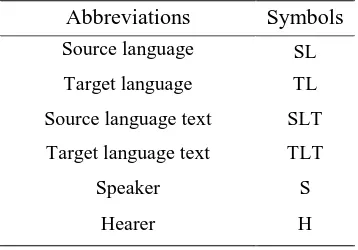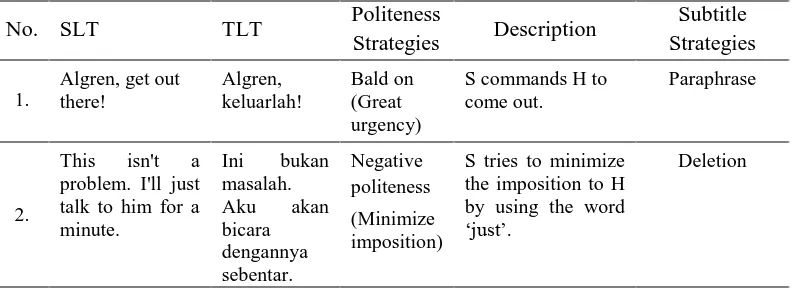Yusup Aji Permana, 2014
AUDIOVISUAL TRANSLATION OF POLITENESS IN “THE LAST SAMURAI” FILM: A STUDY OF ENGLISH INTO INDONESIAN SUBTITLE
Universitas Pendidikan Indonesia | repository.upi.edu | perpustakaan.upi.edu
CHAPTER III
RESEARCH METHODOLOGY
This chapter discusses the methodology applied by the writer in conducting
this study. It comprises formulation of problems, research design, data source,
procedure of data collection and data analysis.
3.1 Research Questions
1. What kinds of politeness strategies are found in the dialogues of “The
Last Samurai” film?
2. What kinds of strategies are used by subtitler in subtitling politeness
strategies in “The Last Samurai” film?
3.2 Research Design
This study was conducted based on a qualitative method. This methodology
plays an important role in directing this study. By using the qualitative method,
the study did not involve a statistical analysis but it only employed a simple
calculation technique (Creswell, 2012). In addition, it was intended to describe an
existing phenomenon, which is politeness in utterances (Huda, 1999, p. 38).
Furthermore, this study collected data from the transcription of film subtitle.
Preissle (as cited in Ratcliff, 2002) posits that the qualitative method:
... is a loosely defined category of research design or models, all of which elicit verbal, visual, tactile, olfactory and gustatory data in the form of descriptive narratives like field notes, recordings, or other transcription from audio- and videotapes and other written records and pictures or film.
In addition, this study employed a descriptive method to facilitate the
interpretation phase which consists of activity such as classifying, analyzing, and
explaining the result of data analysis (Fraenkel and Wallen, 1993, as cited in
Fauziyyah, 2012). The writer assumed that by applying the qualitative and
descriptive methods, the study could yield a comprehensive understanding on the
Yusup Aji Permana, 2014
AUDIOVISUAL TRANSLATION OF POLITENESS IN “THE LAST SAMURAI” FILM: A STUDY OF ENGLISH INTO INDONESIAN SUBTITLE
Universitas Pendidikan Indonesia | repository.upi.edu | perpustakaan.upi.edu
3.3 Data Source
The data, subtitle transcription of „The Last Samurai’ film, were taken as the
material for the study. The writer reasoned that there were plenty and various
realizations of politeness strategies in utterances which were performed by
characters in particular speech event, such as: the interaction between
superior-inferior characters, i.e. the conversation of the emperor of Japan and his advisors;
the higher rank army officer and his subordinate. The interaction between the
equal social status characters, i.e. the conversation among the Emperor‟s advisors.
The last was the interaction between characters from different cultural
background, i.e. conversation between Nathan Algren (U.S army officer) and
Katsumoto (advisor of the emperor of Japan).
Another reason was that the film brings historical knowledge to viewers. It
portrays Japanese historical moment in the reign of The Emperor Meiji. As the
film was listed as the box office film in 2003, it became prime watch-list of
filmgoers in all places at that time. Thus, the film was globally distributed
including to non-English speaking countries such as Indonesia. Therefore, the film
has to be provided with comprehensible subtitles in the target language.
3.4 Data Collection
In this study, the data collection process started from watching the film
entitled “The Last Samurai” and transcribing its subtitle in English and Indonesia
version. By doing that, the writer could grasp the whole conversation and see the
compatibility between characters‟ dialogues and subtitles. This transcription of
subtitle was then used as the primary data in this study, the writer did not use data
sample but rather used the selected data. After that, the collected data were read
and compared to examine the compatibility between the English and Indonesian
version.
Moreover, the writer collected the utterances of all characters in the "Last
Yusup Aji Permana, 2014
AUDIOVISUAL TRANSLATION OF POLITENESS IN “THE LAST SAMURAI” FILM: A STUDY OF ENGLISH INTO INDONESIAN SUBTITLE
Universitas Pendidikan Indonesia | repository.upi.edu | perpustakaan.upi.edu
tied to context, whereas utterances are identified by their context”. According to
that definition, the writer focused on utterances as the object of analysis. The
subtitles of film “The Last Samurai” consist of the spoken utterances. The writer
found the utterances that contain politeness strategies. Furthermore, it was
analyzed and tabulated into types of politeness strategies proposed by Brown and
Levinson (1987). The study found 465 politeness strategies occurrences in 445
selected utterances in “The Last Samurai” subtitle. There were several utterances
containing more than one politeness strategies. This method of the data
calculation, however, brought some weakness to the study. Since, the data
(utterances) was randomly selected; therefore, the result of data analysis did not
illustrate the whole data.
3.5 Data Analysis
In this process, the primary data were analyzed to investigate the pattern that
can be explored to describe the existing phenomena. As Moleong (1995, p. 103)
suggests that the data analysis process comprises of managing, organizing,
categorizing the data. In detail, the procedures of data analysis in this study were
as follows:
1) Clarifying the abbreviation used in this study:
Table 3.1 Abbreviations used in this study
Abbreviations Symbols Source language SL
Target language TL
Source language text SLT
Target language text TLT
Speaker S
Hearer H
2) Comparing the English and Indonesian version
Table 3.2 An example of data source classification
Yusup Aji Permana, 2014
AUDIOVISUAL TRANSLATION OF POLITENESS IN “THE LAST SAMURAI” FILM: A STUDY OF ENGLISH INTO INDONESIAN SUBTITLE
Universitas Pendidikan Indonesia | repository.upi.edu | perpustakaan.upi.edu
(English) (Indonesian)
1. Algren, get out there! Algren, keluarlah!
2. This isn't a problem. I'll just talk to him for a minute. Ini bukan masalah. Aku akan bicara dengannya sebentar.
3) Identifying and classifying the utterances into types of politeness
strategies (Brown and Levinson‟s theory) and subtitling strategies
(Gottlieb‟s theory). In analyzing politeness strategies, the utterances
were classified into: bald-on record, positive politeness, negative
politeness, and off record. After that, examining what kind of subtitling
strategies which were applied by the translator, namely: expansion,
paraphrase, transfer, imitation, transcription, dislocation, condensation,
decimation, deletion, and resignation.
Table 3.3 An example of classification politeness strategies and subtitling strategies
No. SLT TLT Politeness
strategies and subtitle strategies. In the calculation, the writer used
simple calculation technique as described below:
F
P = X 100 %
N
P: Percentage of each type of politeness/subtitle strategies
F: Frequency of each type of politeness strategies/subtitle strategies
Yusup Aji Permana, 2014
AUDIOVISUAL TRANSLATION OF POLITENESS IN “THE LAST SAMURAI” FILM: A STUDY OF ENGLISH INTO INDONESIAN SUBTITLE
Universitas Pendidikan Indonesia | repository.upi.edu | perpustakaan.upi.edu
5) Describing and interpreting the findings of the analysis from tables and
diagrams presentation, and
6) Drawing conclusion based on findings.
3.6 Concluding Remarks
This chapter has explained the research methodology employed in this
study. It consists of the explanation of research design, data source, procedure of
data collection, and data analysis. In the next chapter, the presentation of data

